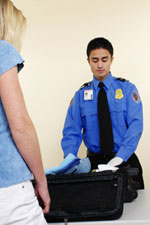|
|
How Air Travel Regulations
Maintain Safety
Air travel regulations help to maintain air travel safety which has always been a number one priority for the aviation industry. The Transportation Security Administration (TSA) is in charge of issuing and enforcing air travel regulations for the United States. With the advent of September 11, 2001, new regulations have been implemented to meet heightened air travel safety risks. The current regulations serve to protect everyone working and traveling on airplanes, including airport employees, flight attendants, pilots, and passengers. The chief safety risk is terrorism, including the dangers of hijacking and the
bombing of airplanes and airports. Air Travel Safety Regulations- One of the relatively newer regulations, enacted June 21, 2008, is the requirement for all passengers to present an acceptable ID at airport checkpoints.
For air travel to or within the U.S, the TSA requires adult passengers (18 and over) to carry a U.S federal or state-issued photo ID with the following information: name, date of birth, gender, and expiration date. If an acceptable ID is not provided, the passenger will have to prove their identity to a Transportation Security Officer, and go through further screening. Individuals who cannot prove their identity are not allowed to fly.

- The “separate liquids” rule is another example of a new air travel regulation, enacted August 10, 2006.
The regulation allows for typical, everyday liquids in small quantities to be carried on the airplane. This helps eliminate the danger of having explosive liquids and materials onboard. Proof of this risk was seen on Christmas Day, 2009, when a passenger tried unsuccessfully to ignite a bomb he had created with liquids and powder. The rule is referred to as the “3-1-1 rule.” You can have 3.4 oz. bottles or less, 1 quart-size plastic bag, and 1 bag per passenger. Larger quantities of liquids will need to be declared separately at the security checkpoint. This practice makes a passenger’s liquid items clearly visible and allows for quicker screening. - The TSA also maintains a list of prohibited items, with distinctions being made between carry-on and checked items.
Sharp, dangerous items are not allowed in the cabin, including knives, box cutters, and razor blades. However, these items are allowed onboard as checked items. Other item categories that follow these guidelines are sporting goods (baseball bats, gold clubs, ski poles), tools, self-defense items, and guns and firearms. - Any item belonging to the explosive and flammable materials, disabling chemicals, and other dangerous item categories are completely prohibited and not allowed onboard the airplane.
For more information and updates regarding air travel regulations, sign up for our free Newsletter.
Was this information useful? Please pay it forward. Here's how..
Would you prefer to share this page with others by linking to it?
- Click on the HTML link code below.
- Copy and paste it, adding a note of your own, into your blog, a Web page, forums, a blog comment,
your Facebook account, or anywhere that someone would find this page valuable.
|
|
Click here to sign up
for our FREE Newsletter
"Aviation Safety News"
![]()

Aircraft Technicians

|
|